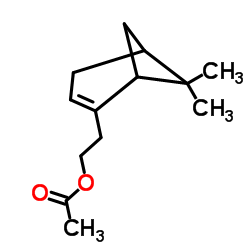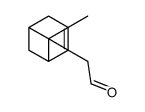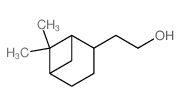128-50-7
| 中文名 | 6,6-二甲基二环[3.1.1]庚-2-烯-2-乙醇 |
|---|---|
| 英文名 | nopol |
| 中文别名 | 6,6-二甲基-二环[3.1.1]庚-2-烯-2-乙醇 |
| 英文别名 |
6,6-dimethyl-2-norpinene-2-ethano
Homomyrtenol 6,6-DIMETHYL-2-NORPINENE-2-ETHANOL EINECS 204-890-3 MFCD00066419 nopyl alcohol 10-HYDROXYMETHYLENE-2-PINENE METHYLOL PINENE Homomyretenol |
| 密度 | 0.978g/cm3 |
|---|---|
| 沸点 | 235ºC at 760mmHg |
| 分子式 | C11H18O |
| 分子量 | 166.26000 |
| 闪点 | 98.9ºC |
| 精确质量 | 166.13600 |
| PSA | 20.23000 |
| LogP | 2.36120 |
| 蒸汽压 | 0.00937mmHg at 25°C |
| 折射率 | 1.492-1.494 |
| 储存条件 | 密封贮藏,储存在阴凉、干燥地方,远离火源。 |
| 稳定性 | 1.常温常压下稳定,避免与不相容材料接触。 2. 与强氧化剂反应。 3. 存在于主流烟气中。 |
| 分子结构 | 1、摩尔折射率:50.11 2、摩尔体积(cm3/mol):169.9 3、等张比容(90.2K):404.6 4、表面张力(dyne/cm):32.1 5、介电常数:无可用的 6、极化率(10-24cm3):19.86 7、单一同位素质量:166.135765 Da 8、标称质量:166 Da 9、平均质量:166.26 Da |
| 计算化学 | 1.疏水参数计算参考值(XlogP):2.1 2.氢键供体数量:1 3.氢键受体数量:1 4.可旋转化学键数量:2 5.互变异构体数量:无 6.拓扑分子极性表面积20.2 7.重原子数量:12 8.表面电荷:0 9.复杂度:215 10.同位素原子数量:0 11.确定原子立构中心数量:0 12.不确定原子立构中心数量:2 13.确定化学键立构中心数量:0 14.不确定化学键立构中心数量:0 15.共价键单元数量:1 |
| 更多 | 1. 性状:无色或浅黄色透明液体 2. 密度(g/mL,20℃):0.9658 3. 相对蒸汽密度(g/mL,空气=1):未确定 4. 熔点(ºC):未确定 5. 沸点(ºC,常压):235, 110ºC(1333pa) 6. 沸点(ºC,8mmHg):未确定 7. 折射率(n20/D):1.492-1.494(lit.) 8. 闪点(ºC):98 9. 比旋光度(º):未确定 10. 自燃点或引燃温度(ºC):未确定 11. 蒸气压(mmHg,20ºC):未确定 12. 饱和蒸气压(kPa,83-85ºC):未确定 13. 燃烧热(KJ/mol):未确定 14. 临界温度(ºC):未确定 15. 临界压力(KPa):未确定 16. 油水(辛醇/水)分配系数的对数值:未确定 17. 爆炸上限(%,V/V):未确定 18. 爆炸下限(%,V/V):未确定 19. 溶解性:未确定 |
Synonym:6,6-Dimethylbicyclo[3.1.1]hept-2-ene-2-ethanol; Bicyclo 3.1.1hept-2-ene-2-ethanol, 6,6-dimethyl-; 6,6-Dimethyl-2-norphinene-2-ethanol; 2-Norpinene-2-ethanol, 6,6-dimethyl Section 2 - COMPOSITION, INFORMATION ON INGREDIENTS
Risk Phrases: 22 Section 3 - HAZARDS IDENTIFICATION EMERGENCY OVERVIEW
Harmful if swallowed. Potential Health Effects Eye: Causes eye irritation. Skin: Causes moderate skin irritation. Ingestion: May be harmful if swallowed. Causes digestive tract irritation. Inhalation: Causes respiratory tract irritation. Chronic: No information found. Section 4 - FIRST AID MEASURES Eyes: Flush eyes with plenty of water for at least 15 minutes, occasionally lifting the upper and lower eyelids. Get medical aid. Skin: Get medical aid. Flush skin with plenty of water for at least 15 minutes while removing contaminated clothing and shoes. Wash clothing before reuse. Ingestion: If victim is conscious and alert, give 2-4 cupfuls of milk or water. Never give anything by mouth to an unconscious person. Get medical aid immediately. Inhalation: Remove from exposure and move to fresh air immediately. If not breathing, give artificial respiration. If breathing is difficult, give oxygen. Get medical aid. Notes to Physician: Section 5 - FIRE FIGHTING MEASURES General Information: As in any fire, wear a self-contained breathing apparatus in pressure-demand, MSHA/NIOSH (approved or equivalent), and full protective gear. During a fire, irritating and highly toxic gases may be generated by thermal decomposition or combustion. Water may be ineffective. Material is lighter than water and a fire may be spread by the use of water. Vapors may be heavier than air. They can spread along the ground and collect in low or confined areas. Extinguishing Media: Use agent most appropriate to extinguish fire. Use water spray, dry chemical, carbon dioxide, or appropriate foam. Section 6 - ACCIDENTAL RELEASE MEASURES General Information: Use proper personal protective equipment as indicated in Section 8. Spills/Leaks: Clean up spills immediately, observing precautions in the Protective Equipment section. Absorb spill using an absorbent, non-combustible material such as earth, sand, or vermiculite. Do not use combustible materials such as sawdust. Provide ventilation. Section 7 - HANDLING and STORAGE Handling: Wash thoroughly after handling. Remove contaminated clothing and wash before reuse. Use with adequate ventilation. Avoid contact with eyes, skin, and clothing. Do not ingest or inhale. Storage: Keep container closed when not in use. Store in a tightly closed container. Store in a cool, dry, well-ventilated area away from incompatible substances. Section 8 - EXPOSURE CONTROLS, PERSONAL PROTECTION Engineering Controls: Facilities storing or utilizing this material should be equipped with an eyewash facility and a safety shower. Use adequate ventilation to keep airborne concentrations low. Exposure Limits CAS# 128-50-7: Personal Protective Equipment Eyes: Wear appropriate protective eyeglasses or chemical safety goggles as described by OSHA's eye and face protection regulations in 29 CFR 1910.133 or European Standard EN166. Skin: Wear appropriate protective gloves to prevent skin exposure. Clothing: Wear appropriate protective clothing to prevent skin exposure. Respirators: A respiratory protection program that meets OSHA's 29 CFR 1910.134 and ANSI Z88.2 requirements or European Standard EN 149 must be followed whenever workplace conditions warrant respirator use. Section 9 - PHYSICAL AND CHEMICAL PROPERTIES Physical State: Viscous liquid Color: colorless Odor: Not available. pH: Not available. Vapor Pressure: Not available. Viscosity: Not available. Boiling Point: 230.0 - 240.0 deg C @ 760.00m Freezing/Melting Point: Not available. Autoignition Temperature: Not available. Flash Point: 98 deg C ( 208.40 deg F) Explosion Limits, lower: Not available. Explosion Limits, upper: Not available. Decomposition Temperature: Solubility in water: Specific Gravity/Density: .9730g/cm3 Molecular Formula: C11H18O Molecular Weight: 166.26 Section 10 - STABILITY AND REACTIVITY Chemical Stability: Stable under normal temperatures and pressures. Conditions to Avoid: Incompatible materials, strong oxidants. Incompatibilities with Other Materials: Strong oxidizing agents. Hazardous Decomposition Products: Carbon monoxide, carbon dioxide. Hazardous Polymerization: Has not been reported Section 11 - TOXICOLOGICAL INFORMATION RTECS#: CAS# 128-50-7: RC8870000 LD50/LC50: CAS# 128-50-7: Draize test, rabbit, skin: 500 mg/24H Moderate; Oral, rat: LD50 = 890 mg/kg; Skin, rabbit: LD50 = >5 gm/kg. Carcinogenicity: Nopol - Not listed by ACGIH, IARC, or NTP. Other: See actual entry in RTECS for complete information. Section 12 - ECOLOGICAL INFORMATION Section 13 - DISPOSAL CONSIDERATIONS Dispose of in a manner consistent with federal, state, and local regulations. Section 14 - TRANSPORT INFORMATION IATA Not regulated as a hazardous material. IMO Not regulated as a hazardous material. RID/ADR Not regulated as a hazardous material. Section 15 - REGULATORY INFORMATION European/International Regulations European Labeling in Accordance with EC Directives Hazard Symbols: XN Risk Phrases: R 22 Harmful if swallowed. Safety Phrases: S 24/25 Avoid contact with skin and eyes. WGK (Water Danger/Protection) CAS# 128-50-7: No information available. Canada CAS# 128-50-7 is listed on Canada's DSL List. CAS# 128-50-7 is not listed on Canada's Ingredient Disclosure List. US FEDERAL TSCA CAS# 128-50-7 is listed on the TSCA inventory. SECTION 16 - ADDITIONAL INFORMATION N/A |
|
毒理学数据: 1、皮肤/眼睛刺激性 标准的Draize试验:兔子,皮肤接触:500mg/24H;反应的严重程度:中度。 2、 急性毒性:大鼠经口LD50:890mg/kg;小鼠经肌肉注射LD50:500mg/kg;兔子经皮肤接触LD50:>5mg/kg; CHEMICAL IDENTIFICATION
HEALTH HAZARD DATAACUTE TOXICITY DATA
|
| 危害码 (欧洲) | Xn: Harmful; |
|---|---|
| 风险声明 (欧洲) | R22 |
|
~99% 
128-50-7 |
| 文献:Pillai, Unnikrishnan R; Sahle-Demessie, Endalkachew Chemical communications (Cambridge, England), 2004 , # 7 p. 826 - 827 |
|
~% 
128-50-7 |
| 文献:Wang, Xueyan; Wang, Tao; Hua, Weiming; Yue, Yinghong; Gao, Zi Catalysis Communications, 2014 , vol. 43, p. 97 - 101 |
|
~86% 
128-50-7 |
| 文献:Ashcroft, Martyn R.; Bougeard, Peter; Bury, Adrian; Cooksey, Christopher J.; Johnson, Michael D. Journal of Organometallic Chemistry, 1985 , vol. 289, p. 403 - 416 |
|
~% 
128-50-7 |
| 文献:Watanabe,S. Bulletin of the Chemical Society of Japan, 1965 , vol. 38, p. 1231 - 1235 |
| 上游产品 2 | |
|---|---|
| 下游产品 6 | |







![Bicyclo[3.1.1]hept-2-ene-2-ethanol,6,6-dimethyl-, 2-(4-methylbenzenesulfonate)结构式](https://image.chemsrc.com/caspic/305/74892-00-5.png)
![Bicyclo[3.1.1]hept-2-ene,2-ethenyl-6,6- dimethyl-结构式](https://image.chemsrc.com/caspic/299/473-00-7.png)


![4-(2-bromoethyl)-6,6-dimethylbicyclo[3.1.1]heptane结构式](https://image.chemsrc.com/caspic/167/53207-03-7.png)